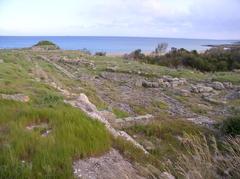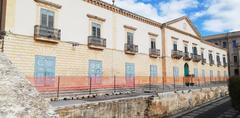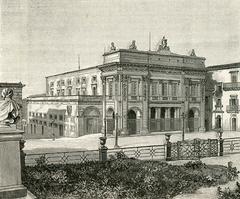Noto Cathedral: Visiting Hours, Tickets, and Historical Highlights in Noto, Italy
Date: 15/06/2025
Introduction
Noto Cathedral (Cattedrale di San Nicolò) dominates the heart of Noto, Sicily, as a masterpiece of Sicilian Baroque architecture and a living emblem of the region’s resilience and cultural vibrancy. Rebuilt after the devastating 1693 earthquake and intricately restored following the 1996 collapse of its dome and nave, the cathedral stands as a testament to both architectural innovation and communal faith. Its luminous golden façade, imposing dome, and pivotal location atop Piazza del Duomo make it a focal point for both religious life and cultural exploration.
Whether you are a history enthusiast, art lover, or a traveler seeking to immerse yourself in Sicily’s UNESCO-listed heritage, Noto Cathedral offers an experience rich in history, artistry, and tradition. This comprehensive guide provides current information on visiting hours, tickets, accessibility, highlights, and nearby attractions—equipping you to make the most of your visit to one of Italy’s most treasured historical sites (UNESCO; TravelNoto.com).
Table of Contents
- Historical Context and Architectural Significance
- Restoration and UNESCO Recognition
- Visitor Information: Hours, Tickets, and Accessibility
- Highlights and Interior Experience
- Events, Etiquette, and Practical Tips
- Nearby Attractions and Suggested Itineraries
- Frequently Asked Questions (FAQ)
- Conclusion and Travel Resources
- Sources and Further Reading
Historical Context and Architectural Significance
Origins and Baroque Rebirth
The origins of Noto Cathedral are intimately tied to the 1693 earthquake, which razed the medieval town of Noto and its original cathedral. In the wake of this catastrophe, the city was relocated and rebuilt in a grand Baroque style that would come to define the Val di Noto region. The construction of the new cathedral began in 1694, guided by architects like Rosario Gagliardi, and spanned several decades, culminating in the completion of its main structure in 1776 (modern-traveler.com; byemyself.com).
Baroque Masterpiece and Urban Integration
Noto Cathedral is the quintessential Sicilian Baroque edifice, featuring a monumental golden limestone façade, grand staircase, and twin bell towers. The design utilizes superimposed columns and ornate reliefs to create visual drama and upward movement, while its central placement in Piazza del Duomo was a deliberate urban planning choice to symbolize the city’s rebirth and the centrality of faith (TravelNoto.com; homeinitaly.com).
Inside, the Latin cross plan, soaring arches, and luminous dome create a serene ambiance, punctuated by polychrome marble altars, restored frescoes, and the silver reliquary of Saint Corrado—Noto’s patron saint.
Restoration and UNESCO Recognition
1996 Collapse and Restoration
A pivotal moment in the cathedral’s modern history occurred in 1996, when the dome and parts of the nave collapsed due to structural weaknesses. The restoration that followed, completed in 2007, was an internationally acclaimed effort that combined traditional methods with modern engineering, ensuring both structural integrity and historical authenticity. The interior was returned to a more restrained, whitewashed aesthetic, highlighting the interplay of light and space (homeinitaly.com; Wikipedia).
UNESCO World Heritage Site
In 2002, Noto and its cathedral were inscribed as part of the “Late Baroque Towns of the Val di Noto” on the UNESCO World Heritage list. This recognition celebrates the extraordinary synthesis of architecture, urban planning, and cultural identity that defines the region (UNESCO).
Visitor Information: Hours, Tickets, and Accessibility
Opening Hours
- General Hours: Open daily from 9:00 AM to 7:00 PM. Note that hours may vary during religious services, major holidays, or special events (TravelNoto.com; Italia.it).
- Best Times to Visit: Early morning or late afternoon for fewer crowds and optimal lighting; late afternoon is especially recommended for photography.
Tickets and Admission
- Entry: The main nave is free to enter. Access to the crypt or bell towers, when open, may require a small fee (usually €2–€3). Combination tickets covering multiple sites are also available and offer good value (Earth Trekkers; Sicilian Traveler).
- Guided Tours: Available through local tourism offices or private guides, often including other Baroque landmarks.
Accessibility
- Physical Access: The main entrance is accessible via a monumental staircase; a ramp is provided for wheelchair users, but internal stairs may limit access to the crypt and dome.
- Assistance: Contact the cathedral at +39 0931 835286 for specific accessibility needs.
Highlights and Interior Experience
Architectural Features
- Façade: Golden limestone, grand staircase, twin bell towers, and ornate Baroque details.
- Interior: Latin cross plan, soaring arches, and a luminous dome with restored frescoes (TravelNoto.com).
- High Altar and Apse: Polychrome marble, gold leaf, and a triptych depicting Saints Nicolò, Corrado, and Guglielmo (Italia.it).
- Relics: The silver urn of Saint Corrado Confalonieri, the city’s patron saint (Wikipedia).
- Stained Glass: New stained glass windows by Francesco Mori light the dome (Wikipedia).
Climbing the Dome
When open, visitors can climb the dome for panoramic views of Noto’s historic center and surrounding countryside. Note that the ascent is via narrow stairs and may not be suitable for those with limited mobility (TheTouristChecklist).
Events, Etiquette, and Practical Tips
Religious Services and Festivals
- Feast of San Corrado: Major religious celebration in February with processions and special masses (TravelNoto.com).
- Infiorata di Noto: Annual flower festival each May, when streets are adorned with elaborate floral carpets (italyscapes.com).
Visitor Etiquette
- Dress Code: Modest attire required—shoulders and knees covered.
- Behavior: Maintain silence during services, no flash photography, and respect restricted areas during religious ceremonies (Sicilian Traveler).
Practical Tips
- Footwear: Wear comfortable shoes for cobblestone streets.
- Refreshments: Enjoy local treats like almond granita at nearby cafés, especially the famed Caffè Sicilia (ASingleWomanTraveling).
- Facilities: Public restrooms are available in the historic center.
Nearby Attractions and Suggested Itineraries
- Palazzo Ducezio: Noto’s city hall, opposite the cathedral (Along Dusty Roads).
- Church of San Domenico and Santa Chiara: Notable Baroque churches nearby.
- Corso Vittorio Emanuele: Main avenue with palaces, shops, and cafés.
- Belvedere Tower (Chiesa di SS. Salvatore): For elevated panoramic views (Travels with Missy).
Allow 1–2 hours for a comprehensive visit to the cathedral and its immediate surroundings.
Frequently Asked Questions (FAQ)
What are Noto Cathedral’s opening hours?
Generally, 9:00 AM to 7:00 PM daily; hours may vary on holidays or for services.
Is there an entry fee?
Entry to the main nave is free; some areas (crypt, bell towers) may have a small fee.
Are guided tours available?
Yes, bookable through tourism offices or online; advance booking recommended for groups.
Is the cathedral wheelchair accessible?
The main entrance is accessible; some internal areas have stairs.
Can I take photos inside?
Yes, but avoid flash and respect restrictions during services.
When is the best time to visit?
Early morning or late afternoon for fewer crowds and best lighting; avoid major festivals for quieter visits.
Conclusion and Travel Resources
Noto Cathedral is an unmissable highlight of Sicilian heritage—offering visitors a unique blend of architectural grandeur, spiritual depth, and lively cultural traditions. With free entry to its awe-inspiring nave, opportunities for panoramic city views, and a calendar rich in festivals and religious events, the cathedral is both a historical monument and a vibrant part of Noto’s daily life.
For the most rewarding experience, plan ahead by checking official opening hours, booking guided tours, and exploring nearby Baroque gems. Utilize digital resources like the Audiala app for up-to-date information, audio guides, and additional travel tips. Embrace the beauty, history, and spirit of Noto Cathedral—and let it inspire your journey through Sicily’s Baroque heart (UNESCO; TravelNoto.com).
Sources and Further Reading
- UNESCO World Heritage: Late Baroque Towns of the Val di Noto
- Modern Traveler: Ragusa vs Noto
- TravelNoto.com – The Cathedral of San Nicolò
- Italia.it – Cathedral of Noto
- Home in Italy – Noto Cathedral
- Sicilian Traveler – Things to Do Noto
- Earth Trekkers – Noto, Sicily
- Along Dusty Roads – Noto Sicily Guide
- ASingleWomanTraveling – Is Noto Worth Visiting?
- The Tourist Checklist – Things to Do in Noto
- Wikipedia – Noto Cathedral
- Rachel IRL – Things to Do in Noto
- ItaliaScapes – Infiorata di Noto 2025




